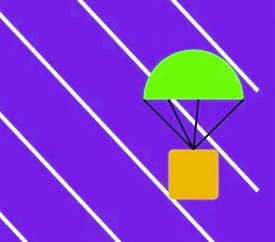
落ちてくる茶色の箱をタッチしたらパラシュートをひらく。ただそれだけの超簡単iPhoneゲームのサンプルを作ってみます。
動作イメージ
XcodeからiOS6 iPhone Simulatorで動かすとこんな感じになります。
ポイント
箱が落ちてくるアニメーションは、CADisplayLinkを使ってLoopの中で箱のcenter座標を更新しています。箱の落ちるスピードを変数で持っておいて、タップした際にその値に変更を加えることで、Loop内部の座標更新のX,Y方向の大きさをコントロールしました。
サンプルコード
#import “ViewController.h”
#import <QuartzCore/QuartzCore.h>
#define UIColorHex(rgbValue) [UIColor colorWithRed:((float)((rgbValue & 0xFF0000) >> 16))/255.0 green:((float)((rgbValue & 0xFF00) >> 8))/255.0 blue:((float)(rgbValue & 0xFF))/255.0 alpha:1.0]
@interface ViewController () {
CADisplayLink *timer;
UIView *parachute;
CGPoint speed;
}
@end
@implementation ViewController
– (void)viewDidLoad
{
[super viewDidLoad];
self.view.backgroundColor = [self color:3];
[self createStripe];
[self startTimer];
}
– (void)startTimer
{
timer = [CADisplayLink displayLinkWithTarget:self selector:@selector(tick:)];
[timer addToRunLoop:[NSRunLoop currentRunLoop] forMode:NSRunLoopCommonModes];
}
– (void)tick:(CADisplayLink*)sender
{
if (parachute) {
parachute.center = CGPointMake(parachute.center.x + speed.x, parachute.center.y + speed.y);
if (!CGRectIntersectsRect(parachute.frame, self.view.bounds)) {
[parachute removeFromSuperview];
parachute = 0;
}
} else {
[self createParachute];
}
}
– (void)createParachute
{
parachute = [[UIView alloc] initWithFrame:CGRectMake(80, 0, 50, 50)];
parachute.backgroundColor = [self color:1];
parachute.layer.cornerRadius = 5;
[self.view addSubview:parachute];
speed = CGPointMake(0, 3);
UITapGestureRecognizer *tap = [[UITapGestureRecognizer alloc] initWithTarget:self action:@selector(openParachute:)];
[parachute addGestureRecognizer:tap];
}
– (void)openParachute:(UITapGestureRecognizer*)gr
{
speed = CGPointMake(1.5, 1.5);
UIBezierPath *path = [UIBezierPath bezierPath];
[path addArcWithCenter:CGPointMake(25, –50) radius:50 startAngle:0 endAngle:M_PI clockwise:NO];
CAShapeLayer *sl = [[CAShapeLayer alloc] init];
sl.fillColor = [self color:0].CGColor;
sl.path = path.CGPath;
UIBezierPath *path2 = [UIBezierPath bezierPath];
[path2 moveToPoint:CGPointMake(-25, –50)];
[path2 addLineToPoint:CGPointMake(25, 0)];
[path2 moveToPoint:CGPointMake(0, –50)];
[path2 addLineToPoint:CGPointMake(25, 0)];
[path2 moveToPoint:CGPointMake(30, –50)];
[path2 addLineToPoint:CGPointMake(25, 0)];
[path2 moveToPoint:CGPointMake(75, –50)];
[path2 addLineToPoint:CGPointMake(25, 0)];
CAShapeLayer *sl2 = [[CAShapeLayer alloc] init];
sl2.fillColor = [UIColor clearColor].CGColor;
sl2.strokeColor = [self color:4].CGColor;
sl2.lineWidth = 2;
sl2.path = path2.CGPath;
[parachute.layer addSublayer:sl];
[parachute.layer addSublayer:sl2];
}
– (void)createStripe
{
UIBezierPath *path = [UIBezierPath bezierPath];
for (int i=0; i<5; i++) {
[path moveToPoint:CGPointMake(20, 100 * i)];
[path addLineToPoint:CGPointMake(300, 100 * (i + 3))];
}
CAShapeLayer *sl = [[CAShapeLayer alloc] init];
sl.fillColor = [UIColor clearColor].CGColor;
sl.strokeColor = [self color:2].CGColor;
sl.lineWidth = 4;
sl.path = path.CGPath;
[self.view.layer addSublayer:sl];
}
– (UIColor*)color:(int)i
{
switch (i) {
case 0:
return UIColorHex(0x70FF2E);
case 1:
return UIColorHex(0xE8B129);
case 2:
return UIColorHex(0xFDFDFD);
case 3:
return UIColorHex(0x6934E8);
case 4:
return UIColorHex(0x0E061A);
default:
break;
}
return nil;
}
– (void)didReceiveMemoryWarning
{
[super didReceiveMemoryWarning];
// Dispose of any resources that can be recreated.
}
@end
